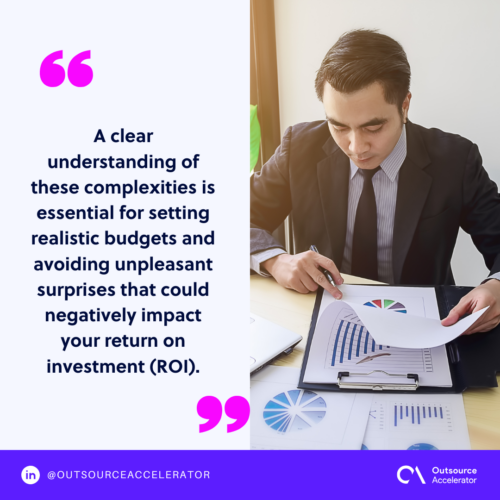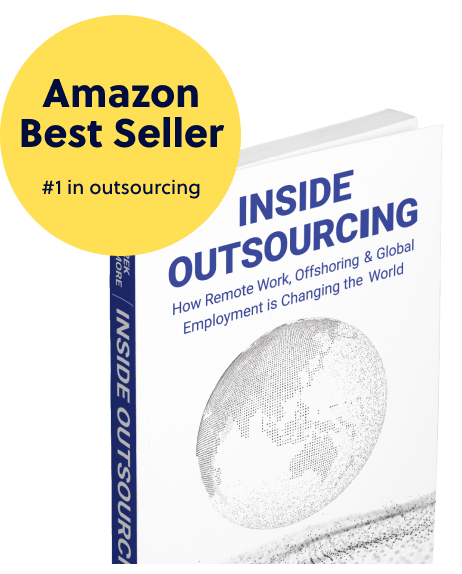The real costs vs. value: Measuring outsourcing ROI in 2026

This article is a submission by Bestarion. Bestarion is a leading outsourcing company in Vietnam with 20+ years of experience bringing innovative IT & Business Solutions to clients worldwide.
The business process outsourcing (BPO) industry is a significant economic sector, with the global market size projected to reach $525.23 billion by 2030. It’s growing at a compound annual growth rate (CAGR) of 9.6% from 2024 to 2030, according to Grand View Research Inc.
This requires a strategic approach to accurately measure return on investment (ROI). Strategic outsourcing can yield significantly higher ROI than in-house operations.
Some studies report up to a 231% ROI depending on the industry and function outsourced, compared to around 60% for internal management.
However, outsourcing success goes beyond cost-cutting. Depending on the function and industry, outsourcing can reduce costs by 6% to 70%.
The real gains come from partnering with the right providers and implementing a well-defined strategy.
Customer experience remains a top priority, with 73% of CX leaders ranking agent performance and service quality as their most important focus. Moreover, around 60% of business executives are willing to invest more in exchange for higher-quality services and access to advanced, innovative technologies.
As we move into 2026, the focus shifts toward evaluating outsourcing not just in terms of cost but in terms of overall value. This article offers a comprehensive look at ROI—covering financial savings, improved efficiency, and long-term operational advantages.
This evidence-driven guide is designed to help you make smarter, value-focused decisions when considering BPO and IT outsourcing for your organization.
Understanding the true costs of outsourcing in 2026
Outsourcing expenses extend far beyond the initial contract price. Research shows that hidden or overlooked costs can add anywhere from 14% to 60% to the total outsourcing spend.
A clear understanding of these complexities is essential for setting realistic budgets and avoiding unpleasant surprises that could negatively impact your return on investment (ROI).

Direct financial expenditures
These include:
- Service provider fees
- Initial setup charges
- Technology investments (hardware, software, licenses)
Industry experts estimate that outsourcing can reduce employment-related expenses—such as recruitment, salaries, and infrastructure—by up to 70%.
However, this calculation often overlooks legal and contract-related fees involved in vendor selection and onboarding.
Additionally, regional taxes and commissions can vary significantly. For example, software service tax requirements differ widely across U.S. states, creating added complexity in budgeting.
Hidden operational costs
Operational costs often come as the biggest surprise. Many of these hidden expenses only become apparent after the partnership begins.
Key examples include:
- Quality-related issues, which can account for 5% to 12% of a company’s revenue
- Cultural and communication barriers, requiring investment in training and collaboration tools
- Knowledge transfer inefficiencies, which can result in lost institutional knowledge
- Ongoing vendor management, which requires dedicated staff and tools for monitoring and governance
Research indicates that approximately 14% of outsourcing initiatives fail, often because companies underestimate or ignore these less obvious costs.
Transition and implementation expenses
Switching to an outsourcing model typically requires substantial upfront investment. These so-called “bubble costs” occur during the knowledge transfer phase, when both internal and external teams must be funded simultaneously.
Implementation costs may include:
- Training and onboarding
- Software integration
- Productivity loss during changeover
Many companies also underestimate productivity loss during the transition period, which frequently lasts longer than anticipated.
Risk-related costs
Risk management is emerging as one of the most critical—and costly—aspects of outsourcing in 2026. As organizations place greater emphasis on data protection and regulatory compliance, a significant portion of outsourcing budgets now goes toward:
- Information security infrastructure
- Compliance with data privacy laws and industry standards
- Contingency planning for geopolitical risks and currency fluctuations
- Intellectual property (IP) protection and legal safeguards
Recent industry analysis shows that outsourcing engagements lacking strong governance structures often fail to deliver intended results. While these may not show up as line-item costs, the value lost through poor execution can be just as damaging to ROI.
Top consulting firms recommend developing a comprehensive risk management framework to identify these potential costs before entering any outsourcing agreement.
Being proactive allows companies to plan effectively, maintain control over their budgets, and maximize the long-term value of their outsourcing partnerships.
The changing definition of ROI in outsourcing
In the past, direct cost savings were used to calculate the return on investment of outsourcing. Companies would offshore tasks to lower-wage countries to reduce payroll expenses.
While that remains part of the strategy, organizations now recognize that a simplistic cost-centric view overlooks the broader value outsourcing offers.
The modern ROI equation includes:
Broader value components:
- Expertise access: Outsourcing provides skilled professionals in areas like AI, cybersecurity, and finance.
- Operational flexibility: Easily scale up or down with demand.
- Speed-to-market: Providers bring established tools and methods that accelerate delivery.
- Productivity: Advanced automation tools and best practices improve performance.
- Strategic focus: Internal teams can concentrate on innovation and core objectives.
Financial benefits beyond cost savings
1. Access to specialized skills and talent
Outsourcing provides access to global talent pools and domain experts who may be unavailable or unaffordable in-house. Whether it’s AI development, cybersecurity, or accounting for CPA firms, outsourcing partners offer specialized knowledge that drives performance and quality.

2. Scalability and flexibility
Without the drawn-out process of hiring or firing staff, outsourcing partners enable companies to swiftly scale operations up or down.
This elasticity is especially useful in seasonal industries or during periods of growth or restructuring.
3. Faster time to market
ITO and BPO providers often bring pre-built solutions, experienced teams, and streamlined processes. These factors accelerate development and deployment, allowing businesses to respond quickly to market demands.
4. Improved efficiency and productivity
External partners often use advanced technologies, automation tools, and best practices that may not exist internally.
These capabilities improve the efficiency of tasks like software development, data processing, or customer service.
5. Strategic focus on core business
By outsourcing non-core tasks, companies can allocate more internal resources to core business functions like innovation, product development, and strategic planning.
Building a smart ROI framework
Your outsourcing investment needs a reliable ROI framework built on strategic metrics and consistent measurement practices. Success depends on knowing how to track both financial returns and qualitative benefits over appropriate timeframes.
1. Setting relevant KPIs
The right Key Performance Indicators (KPIs) are the foundations of any effective outsourcing ROI measurement system. These metrics must line up with your company’s strategic vision and specific outsourcing goals.
Most organizations start by setting clear objectives through the SMART framework. This ensures KPIs are Specific, Measurable, Achievable, Relevant, and Time-bound.
Examples:
- Customer service BPO: First Contact Resolution (FCR), Customer Satisfaction (CSAT)
- IT outsourcing: Time-to-market, System uptime
- BPO (General): Cost per acquisition, Operational efficiency
2. Defining measurement timeframes
Your assessment timeframe greatly affects how you measure outsourcing success. Industry experts note that ROI calculations change dramatically between short-term cost reductions and long-term strategic benefits.
A detailed evaluation needs regular reporting cycles with periodic performance updates that enable quick adjustments.
Good governance requires monitoring both immediate transition phases and ongoing relationship management.
Your measurement schedule should match your outsourced functions’ natural lifecycle. More frequent assessments happen during implementation and stabilization periods.
3. Balancing quantitative & qualitative metrics
Quantitative ROI gives you numbers to work with, but a detailed framework must include qualitative benefits that affect your bottom line. This balanced approach looks at tangible metrics and intangible benefits.
- Quantitative: Cost reductions, SLA adherence, resource utilization
- Qualitative: Brand reputation, adaptability, employee satisfaction
The Balanced Scorecard Methodology provides a structured way to integrate financial and non-financial metrics. This helps assess outsourcing partnerships from multiple points of view.
The most effective ROI frameworks look at both financial performance and contributions to long-term strategic goals.
A balanced framework to evaluate outsourcing ROI
To truly understand the ROI of ITO and BPO, businesses must look at both tangible and intangible metrics:
Tangible metrics:
- Reduction in operating costs
- Increase in speed-to-market
- SLA compliance rates
- Uptime and system reliability
- Customer response time
Intangible metrics:
- Brand reputation enhancement
- Innovation capabilities
- Employee satisfaction and redeployment
- Business agility and adaptability
Evaluating ROI over a longer time horizon also helps capture the compounding value of improved processes, continuous innovation, and better customer experiences.
Industry benchmarks for outsourcing ROI
Different industries get widely varying returns on their outsourcing investments. Industry-specific measures give you a realistic foundation to evaluate your outsourcing strategy’s performance against current standards.
IT outsourcing ROI standards
IT outsourcing delivers substantial returns in multiple ways. Recent research shows that internal IT teams spend 30-40% of their time on repetitive, low-level tasks.
So, organizations that outsource these functions see remarkable improvements in efficiency.
IT outsourcing key measures include:
- Total headcount reduction: 12% to 62%
- Application development budget savings: 11% to 21%
- IT infrastructure operational cost reduction: 16% to 48%
- Overall IT operations cost savings: 21% to 55%
IT outsourcing creates value through access to specialized expertise. Organizations find technical advantages they couldn’t afford to develop internally.
Outsourcing lets them use innovative technology without direct ownership costs.
BPO performance metrics
Business Process Outsourcing (BPO) success depends on balancing cost reductions with service quality. Examples:
- Cost reductions: 6%–41%
- Customer retention improvement: 2%–23%
- High-performance indicators:
- FCR (First Contact Resolution) > 80%
- CSAT (Customer Satisfaction Score) > 80%
- NPS (Net Promoter Score) growth
Average Handling Time (AHT) and service level agreements help determine cost efficiency and service quality. Companies that track these metrics build stronger vendor relationships and optimize processes better.
Manufacturing and operations benchmarks
Manufacturing outsourcing benefits show up across several operational areas. Measured improvements include:
- Maintenance cost reductions: 15% to 30%
- Equipment efficiency improvements: 5% to 19%
- Inventory level reductions: 13% to 38%
Manufacturing outsourcing ROI takes longer to materialize than other industries due to complex implementation needs. Organizations find that better equipment efficiency through outsourced maintenance improves production processes overall.
Manufacturing measures differ from service-based outsourcing metrics. They include tangible production improvements along with cost considerations.
Manufacturers must also factor in quality improvements, reduced downtime, and supply chain optimization to calculate their complete ROI.
Working with outsourcing consulting firms for greater value
Strategic expertise in outsourcing complexities is something many organizations don’t have in-house. Expert consulting firms become valuable partners throughout the outsourcing experience and give an explanation that can affect your outsourcing ROI by a lot.

When to participate with consultants
The right moment to bring in outside expertise is a vital decision point. We needed consultants because our task list grew extensively and business suffered from inaction.
These external advisors deliver the most value during rapid growth periods. Business owners must scale operations and move resources toward their core product or service at this stage.
Consultants become most helpful when:
- You’re learning new capabilities or business lines
- Tasks need specialized skills your in-house team lacks
- High-level advisory assistance is needed for strategic growth decisions
- Testing outsourcing without major commitments makes sense
- Your team can’t get ahead or focus on their strengths
Note that outsourcing consultants add the most value with complex initiatives or first-time transitions to outsourced services. Currently, about one-third of business leaders plan to outsource some operations, which makes consultant selection crucial.
Cost vs. value of consulting services
Consulting services add extra expense, but evidence shows their value often surpasses their cost. Organizations that worked with consultants reported higher satisfaction and smoother transitions in their outsourcing arrangements.
The guidance from experienced consultants can prevent mistakes that get pricey, since 14% of outsourcing operations ended up as failures.
Outsourcing consulting services‘ value has vital expertise in designing effective RFPs, defining service levels, and structuring pricing components. These consultants offer systematic approaches to make decisions predictable while they help review industry leaders like Accenture, TCS, and Cognizant.
The investment yields returns through avoided pitfalls and optimized contracts, despite initial “sticker shock” for growing businesses. Cost-conscious organizations can opt for fixed-price arrangements or have internal employees manage the selection process with business subject matter experts.
Case studies illustrating value over cost
1. A U.S. healthcare provider outsourcing data management
The provider reduced its data entry cost by 35% through BPO services. However, the larger ROI came from improved data accuracy, faster claims processing, and better patient satisfaction.
2. E-commerce firm using ITO for custom software development
By outsourcing its software development, the firm cut costs by 20%, but more importantly, it launched new features twice as fast, gaining a 30% increase in customer retention.
3. Accounting firm outsourcing bookkeeping services
CPA firms outsourcing to BPO providers in Vietnam not only saved on salaries but also improved accuracy and client satisfaction due to the use of AI-driven accounting tools.
FAQs
Q1. How can companies accurately measure the ROI of outsourcing in 2026?
Companies can measure outsourcing ROI by establishing a comprehensive framework that includes both quantitative and qualitative metrics.
This involves identifying key performance indicators, setting appropriate measurement timeframes, and balancing financial metrics with intangible benefits such as increased flexibility and access to specialized expertise.
Q2. What are some hidden costs of outsourcing that businesses often overlook?
Hidden costs of outsourcing can include management and coordination expenses, quality-related issues, cultural and communication challenges, knowledge transfer inefficiencies, and vendor management costs.
Additionally, businesses should consider transition and implementation expenses, as well as risk-related costs such as information security investments and regulatory compliance measures.
Q3. How do outsourcing ROI benchmarks differ across industries?
Outsourcing ROI benchmarks vary significantly across industries. For example, IT outsourcing can lead to cost savings of 21% to 55% in overall operations, while manufacturing outsourcing can result in maintenance cost reductions of 15% to 30% and inventory level reductions of 13% to 38%.
BPO performance metrics often focus on customer satisfaction and operational efficiency.
Q4. When should a company consider hiring an outsourcing consulting firm?
A company should consider hiring an outsourcing consulting firm when exploring new capabilities, lacking specialized skills in-house, needing strategic growth advice, or when ready to test outsourcing without significant commitments.
Consultants are particularly valuable during periods of rapid growth or when transitioning to outsourced services for the first time.
Q5. What are the potential returns on investment for successful outsourcing initiatives?
Successful outsourcing initiatives can yield impressive returns, with some companies achieving up to a 231% ROI through strategic outsourcing. However, these returns depend on careful planning, implementation, and ongoing management of the outsourcing relationship.
Companies can typically expect to reduce operational costs by 6% to 41% through effective outsourcing strategies.







 Independent
Independent




